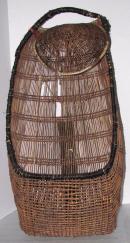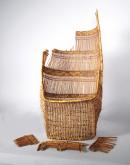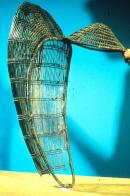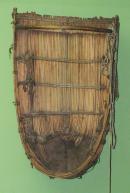The California region includes most of the modern state, except for a portion of the north and east, which can be considered parts of other regions. Californian cradles from the Pomo (4) and Hupa (3) are included in MPM’s collection. The cradles of these groups are known by two names. They are called “sitting” cradles, because the base of the cradle forms a seat for the child, and they are also called “cradle baskets” because of their construction. This type of cradle is unique to the region. The cradle baskets are woven from flexible plant materials like willow or dogwood, which are cut and bent to form wooden rods. These are lashed to a circular wooden bow and hitched together with cotton or jute fiber. For Pomo cradles, gender could be indicated by the colors of the rods, the decorations hanging from the bow, or the design woven into the tumpline, but it was not as strict a practice as in the Great Basin. A miniature basket, quail scalp, or a pattern of diamonds often indicated a female occupant; a deer scrotum, dove head, or diagonal lines indicated a male. Swaddling made of tule was often used because it was easily washed and reused. Children could also be swaddled in cloth or skins and laced inside.
Hupa cradles are usually woven in an openwork pattern, meaning that there are spaces between rods or hitches. They also have a basket-like bottom portion called a toe that forms an elevated seat. This design allows the child’s feet to swing freely if the cradle is rested on the ground. These cradles were created from hazel or willow shoots and hitched together with roots or cordage. Laces of hide or cord to secure the child were usually tied to these hitches. A small circular plate, called a sunshade, was sometimes included to protect the child’s face and was often tied to the side of the cradle when not in use. These cradles were sometimes decorated with charms or amulets hung on a lace strung from one end of the handle to the other, above the child’s head. As with other woven cradles, designs could also be achieved by using differently colored materials.








